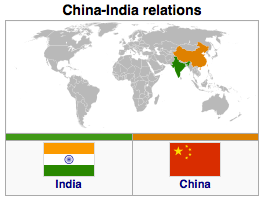A Militarizing India: China-India Relations Facing A New Halt? – Analysis
By JTW
By Emre Tunç Sakaoğlu
On the path to becoming an emerging power globally, India has successfully tested an inter-continental ballistic missile (ICBM) named Agni-V last Thursday. India took a major leap in its strategic capability vis-à-vis China by the same token, as successfully test-firing this nuclear-capable, 5000 km-range missile, named Agni-V, means major cities of China have been brought under the cover of the Indian military.[1]
“Indeed, at the moment there is still a huge asymmetry in China’s favor,” said Uday Bhaskar, the former head of the Institute of Defense Studies and Analyses, with regard to a comparison between the military might of the two giants. However; after adding the missile to its arsenal, “India’s deterrent profile in the region would be appropriately burnished.”[2]

France, Russia, China and the United States are countries which are known to already have this technology, while Israel is believed to have developed such missiles.[3]
India has loosened the purse strings on defense in recent years to join the club of ICBM-operating countries listed above. New Delhi’s deterrence capability is today at its apex, thus New Delhi will from now on have the trump card of ICBM technology, which will strengthen its hand in the multilateral arena as well as in possible bilateral confrontations with China, according to many international defense experts.
Is New Delhi on Its Own?
According to the Times of India, India’s Defense Research and Development Organization (DRDO) chief Saraswat said the missile had been achieved despite the stringent export control regimes, which developed countries have imposed on India.
“This shows that self-reliance in the area of this technology is now becoming a reality,” he said.[4]
The same source also notes that Saraswat further added “the DRDO would now develop multiple independently targetable re-entry vehicles for anti-satellite system.”[5]
But India is not all alone at her task of militarizing rapidly. Interactions with Russia are again to be expanded soon, as an air-launched variant of the BrahMos missile is planned and expected to be tested in late 2012. It will make India one of the few countries in the world with supersonic missiles.[6]
The BrahMos missile, developed through a joint venture of Russia and India, is one of the fastest cruise missiles in the world today, and it is designed to be utilized particularly during naval conflicts.[7] Indeed, earlier this year, the Indian naval forces received a nuclear submarine, capable of carrying BrahMos missiles, from Russia again. Furthermore, India is expected to add to her naval arsenal a “retrofitted” Soviet aircraft carrier in the following months.[8]
Mountains of Hopelessness
Sino-Indian relations can be characterized with border disputes and conflicts of interest due to a race for influence over bordering territories and the waters of Indo-China. The Sino-Indian War of 1962, the Chola Incident in 1967, and the 1987 Sino-Indian skirmish mark historical points of high tension between Beijing and New Delhi.[9] Although efforts to reestablish diplomatic and economic ties have achieved success to some extent since the late 1980s and China emerged as the largest commercial partner of India in 2008, a border dispute along south-western Tibet still occupies foreign policy agendas in New Delhi and Beijing.
India has as well been suspicious of Beijing’s efforts to increase its influence in the Indian Ocean, particularly in recent years. China’s strong strategic relations with India’s arch-rival Pakistan forther raise eyebrows on the Indian side. China, while referring to the reasoning behind its solid support toward Pakistan’s international position, expresses deep concerns regarding India’s military and economic activities in the South China Sea, which is still disputed among several regional states.[10]
Although for today the U.S. and China seem to overlook, at least in the official discourse, the rapid militarization efforts of India,[11] a policy of either appeasement or at least of connivance may not be affordable in the long run as rising tensions over disputes between India and China may lead both the U.S. and China to take pre-cautionary measures against the growing power of India subtly supported by Russia.
References
1. The Times of India, retrieved from http://articles.timesofindia.indiatimes.com/2012-04-19/india/31366890_1_wheeler-island-agni-v-nuclear-capable
2. Ibid.
3. Ibid.
4. The Times of India, retrieved from http://articles.timesofindia.indiatimes.com/2012-04-19/india/31367133_1_agni-v-k-saraswat-wheeler-island
5. Ibid.
6. Global Security Website, retrieved from http://www.globalsecurity.org/military/world/india/navy-intro.htm
7. Ibid.
8. Ibid.
9. Maxwell, N. ‘Sino-Indian Border Dispute Reconsidered’, Economic & Political Weekly, 34, 15. April 10 – 16, 1999.
10. The Hindu, retrieved from http://www.thehindu.com/news/international/article2455647.ece
11. Karnad, B. ‘India’s force planning imperative: the thermonuclear option’, in D. R. SarDesai and Raju G. C. Thomas (eds.) , Nuclear India in the Twenty-First Century (Palgrave: New York, 2002), pp. 106 – 138.
